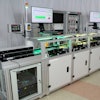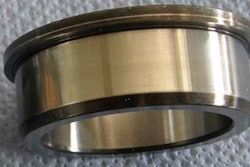Predictive maintenance is the next big thing in maintenance operations. While very few are effectively using predictive maintenance today, there are opportunities abound. Simply put, predictive maintenance is a technique used to assess the equipment condition while the equipment is still in operation – all to help prevent a failure. And this is where maintenance operations is headed to help improve overall equipment effectiveness, reduce costs and increase productivity.
While preventive maintenance is the routine care of your equipment, similar to getting an oil change for your car every 3,000 miles, predictive maintenance is based on actual wear and tear, where you might check the oil temperature while the car is operating at 55 mph. The goal is to find the balance of a consistent preventive maintenance schedule that helps prevent failures while not over maintaining equipment and utilizing a series of cloud-enabled smart tools and IoT-enabling software to collect and evaluate data and monitor conditions.
Many of today’s 24/7 manufacturing floors are still working in run-to-fire reactive mode and dealing with problems as they arise. However, treating the symptoms, once something is broken, is not only inefficient, but can hold up entire production lines and negatively impact the bottom line. Instead, increasing machine availability starts with a solid preventive maintenance program that helps fuel a sound predictive maintenance program.
Forward-looking manufacturing maintenance or plant managers are pulling data manually or even have smart and connected equipment already delivering data automatically. But what do you do with that data? How you best use the data to balance reactive and proactive maintenance are common challenges to successful predictive maintenance programs.
So what’s required to move in the direction of predictive maintenance and why should you care? Here are three key elements that serve as the foundation for any successful predictive maintenance program.
1) Establish a solid preventive maintenance program.
Like the aforementioned oil change example, preventive maintenance is a critical part of maintenance management, as it helps keep equipment up and running, averting any unplanned downtime or unexpected expenses based on equipment failure. When conducting preventive maintenance for a manufacturing plant or an industrial facility, trained staff will be better able to detect potential issues and correct them before they have a negative impact on an organization. Unlike corrective or reactive maintenance (which involves generating a work order request in response to an existing failure), preventive maintenance helps mitigate failures before they occur.
While setting up a preventive maintenance program can seem like a daunting task – as it requires inputting data on hundreds or thousands of pieces of equipment and identifying the correct tasks for each – it drives cost savings and resource efficiency. Often there are ways to ease this task. In fact, computerized maintenance management system (CMMS) providers can help auto upload and transition data from existing excel sheets or another solution or provide onsite help if moving online from a paper-based system.
Preparation and planning often prove to be the toughest parts of kicking off a preventive maintenance program. However, scheduled maintenance is essential as it helps track machine and equipment status documentation. It is also essential to review data in order to prioritize tasks. Look at what emergency reactive work items are trending and where. If repairing specific hardware is a large part of responsive work at one location and replacing drive shafts is an issue elsewhere, maintenance managers should create basic inspection routines for that specific equipment and see if trends change. Routines can be updated over time with schedule details such as tools and supplies to take, procedures to follow, and more.
2) Ensure you have access to cloud-enabled and smart tools.
With an effective preventive maintenance program in place, the next step is ensuring access to smart and cloud-enabled tools that automatically collect machine data. Most machinery today is equipped with Programmable Logic Controls (PLC), which are one of the essential components of a predictive maintenance program, but many manufacturers are not doing anything with the resulting data. PLC controllers auto collect data such as temperature, uptime, downtime, flow rates, vibration analysis, and more. Information stored on a PLC can help with diagnosing an asset. Often times, however, plant managers are looking at the data too late – once there is already a problem – or don’t know what to do with the data. Some don’t even realize they have access to this data in real-time, or at all. This is where software bridges the gap.
Smart equipment and sensors on the plant floor are increasingly able to provide diagnostic information through connectivity to a CMMS, leading to better problem analysis and decision-making. This has positive impacts on parts inventory and supply chain as well. Smart equipment integrations with CMMS software not only track the data but can also detect patterns that indicate a pending problem and send auto alerts. For example, there is a deteriorating motor on a conveyor that requires a part replacement but the part is in a warehouse two time zones away. In reactive mode, the motor might breakdown and the replacement part could require a 7-10 day lead-time, dramatically impacting production. But with predictive maintenance, integration, and a best-in-class CMMS, the process of finding and sourcing parts takes place before the breakdown so the parts are ready when needed for ultimate productivity and asset availability.
3) Utilize change management best practices.
“People, Process, Technology” has long been a mantra and business best practice for effective change management. Embarking on a predictive maintenance journey (or even a preventive maintenance journey) is a big change for many manufacturers. While we’ve addressed some of the technology changes, a move to predictive maintenance also requires a strong focus on the people and process elements.
Having the right team in place can make or break predictive maintenance. Effective leadership that not only wants productivity and cost benefits but also values new approaches is essential to adopting and enabling a new philosophy. This requires a vision of the goal and an openness to continual improvement. Just because the team and process has been the same for years doesn’t mean there aren’t opportunities for improvement. A successful predictive management program implementation requires a forward-looking and empowering executive sponsor and a manufacturing leader who is dedicated to the effort. While there can be generational challenges to implementing large-scale technology-driven changes, sharing positive ROI and bottom line impacts can help convince less progressive executives to be more open and willing to make the reactive to proactive to predictive journey.
Internal processes also need to be addressed to align the mission of the plant operations manager with efficient plant management on the maintenance floor. Lean manufacturing practices often simplify this process as there is a focus on continual improvement and an open mind to reassess. With predictive maintenance, the process is key. The right processes have to be in place to effectively condition the team to utilize the right tools for data capture and be committed to the effort. Some manufacturers have PLC controller devices or have meters and gauges on assets but are not routinely capturing data. Preventive maintenance ensures data-capture through auto-set tasks. Good preventive maintenance also leverages smart tools such as infrared thermography to measure temperatures and mitigate overheating risks and ultrasonic analysis to listen for abnormalities.
Predictive maintenance is not a set it and forget about it approach. Like any big technology-driven shift, what you gain in complexity you may lose in ease of use or adoptability. Go into this effort with an open mind and adaptability as the biggest benefits of predictive maintenance are cost reduction and productivity but even preparing for predictive maintenance has its benefits. Once put in place visibility into the data collected can allow insight into asset condition and correlated maintenance activity. This helps managers understand what activity has the biggest impact on machine reliability.
Ray Kharawala is a senior manufacturing sales engineer for Dude Solutions, a leading software-as-a-service (SaaS) provider of operations management solutions to education, government, healthcare, manufacturing and membership-based organizations.























